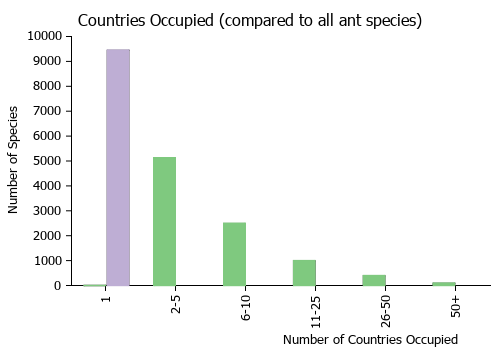Technomyrmex cedarensis
| Technomyrmex cedarensis | |
|---|---|

| |
| Scientific classification | |
| Kingdom: | Animalia |
| Phylum: | Arthropoda |
| Class: | Insecta |
| Order: | Hymenoptera |
| Family: | Formicidae |
| Subfamily: | Dolichoderinae |
| Genus: | Technomyrmex |
| Species: | T. cedarensis |
| Binomial name | |
| Technomyrmex cedarensis Forel, 1915 | |
Technomyrmex antonii and cedarensis are both common in the sclerophyll woodlands of south-east Queensland and north-east New South Wales. T. cedarensis is found under stones and forages both terrestrially and arboreally. (Steven O. Shattuck, unpublished)
Identification
Bolton (2007) - A member of the T. cedarensis complex in the Technomyrmex albipes group. This taxon was originally described as a variety of Technomyrmex albipes, but cedarensis is a separate, strictly Australian species that has larger, more posteriorly placed eyes and setae present on the dorsum of the head behind the level of the eyes.
T. cedarensis is closest related to two other Australian species, Technomyrmex antonii and Technomyrmex australops, which resemble it closely. All three have relatively large, posteriorly placed eyes sculptured head and a single pair of setae on the dorsum of the head behind the level of the posterior margin of the eye. In fact, antonii and cedarensis may be nothing more than colour variants of a single species, so close is the resemblance. They are retained as separate species here but a more detailed investigation of the taxonomy of these two is required. T. australops has even larger eyes than either of these two, and has setae present on the mesonotum.
Keys including this Species
Distribution
Latitudinal Distribution Pattern
Latitudinal Range: -12.41666667° to -33.66666667°.
| North Temperate |
North Subtropical |
Tropical | South Subtropical |
South Temperate |
- Source: AntMaps
Distribution based on Regional Taxon Lists
Australasian Region: Australia (type locality).
Distribution based on AntMaps
Distribution based on AntWeb specimens
Check data from AntWeb
Countries Occupied
| Number of countries occupied by this species based on AntWiki Regional Taxon Lists. In general, fewer countries occupied indicates a narrower range, while more countries indicates a more widespread species. |

|
Estimated Abundance
| Relative abundance based on number of AntMaps records per species (this species within the purple bar). Fewer records (to the left) indicates a less abundant/encountered species while more records (to the right) indicates more abundant/encountered species. |

|
Biology
Castes
Nomenclature
The following information is derived from Barry Bolton's Online Catalogue of the Ants of the World.
- cedarensis. Technomyrmex albipes var. cedarensis Forel, 1915b: 85 (w.q.) AUSTRALIA. Raised to species: Bolton, 2007a: 112.
Unless otherwise noted the text for the remainder of this section is reported from the publication that includes the original description.
Description
Worker
Bolton (2007) - TL 2.6 - 2.9, HL 0.64 – 0.74, HW 0.56 - 0.68, SL 0.62 - 0.78, PW 0.39 - 0.50, WL 0.84 - 0.96 (18 measured). Indices: CI 86 - 92, SI 107 - 115, OI 29 - 32, EPI 104 - 120, DTI 120 133.
Frontal carina with 2 setae: in profile the posterior at about the level of the anterior margin of the eye. Dorsum of head posterior to this with only a single pair of setae, in profile located between the level of the posterior margin of the eye and the posterior margin of the head; all these setae are shorter than the maximum diameter of the eye. With head in full-face view the eyes relatively large, located just behind the midlength of the sides and their outer margins break the outline of the sides; also in full-face view the posterior margin is not indented medially, instead the margin is transverse to evenly and very shallowly concave medially. Number of setal pairs on mesosoma: pronotum 1 - 2 (usually 2); mesonotum 0; propodeal dorsum 0; lateral margins of propodeal declivity sometimes 0, but often 1 - 2 present, short. Mesonotal dorsum in profile evenly convex. Propodeal dorsum short, shorter than depth of declivity to the spiracle, the dorsum and declivity meet in an angle. Gastral tergites 1 - 4 each with numerous setae present; longest setae on the first tergite are shorter than the maximum diameter of the eye. Head, mesosoma, petiole and gaster usually a uniform dark brown. On middle and hind legs the coxae, femora and tibiae are usually the same shade as the mesosoma; trochanters and tarsi are paler, usually dull yellow. In some workers the coxae are lighter than the mesosoma and femora, the femora being intermediate in shade between the lighter coxae and darker mesosoma.
Type Material
Bolton (2007) - Syntype workers, Australia: Queensland, Cedar Creek, iii.l913, no. 169 (Mjoberg); syntype queen, same locality but iv.19lJ, no. 115 (Mjoberg) (Musee d'Histoire Naturelle Genève) [examined].
- Syntype, 1 worker, Ravenshoe (as Cedar Creek), Queensland, Australia, Mjoberg,E., ANIC32-014999, Australian National Insect Collection.
- Syntype, 4 workers, 1 male, Ravenshoe (as Cedar Creek), Queensland, Australia, Musee d'Histoire Naturelle Genève.
References
- Bolton, B. 2007. Taxonomy of the dolichoderine ant genus Technomyrmex Mayr (Hymenoptera: Formicidae) based on the worker caste. Contributions of the American Entomological Institute. 35(1):1-149.
References based on Global Ant Biodiversity Informatics
- Bolton B. 2007. Taxonomy of the dolichoderine ant genus Technomyrmex Mayr (Hymenoptera: Formicidae) based on the worker caste. Contributions of the American Entomological Institute 35(1): 1-150.
- CSIRO Collection
- Taylor R. W. 1987. A checklist of the ants of Australia, New Caledonia and New Zealand (Hymenoptera: Formicidae). CSIRO (Commonwealth Scientific and Industrial Research Organization) Division of Entomology Report 41: 1-92.

